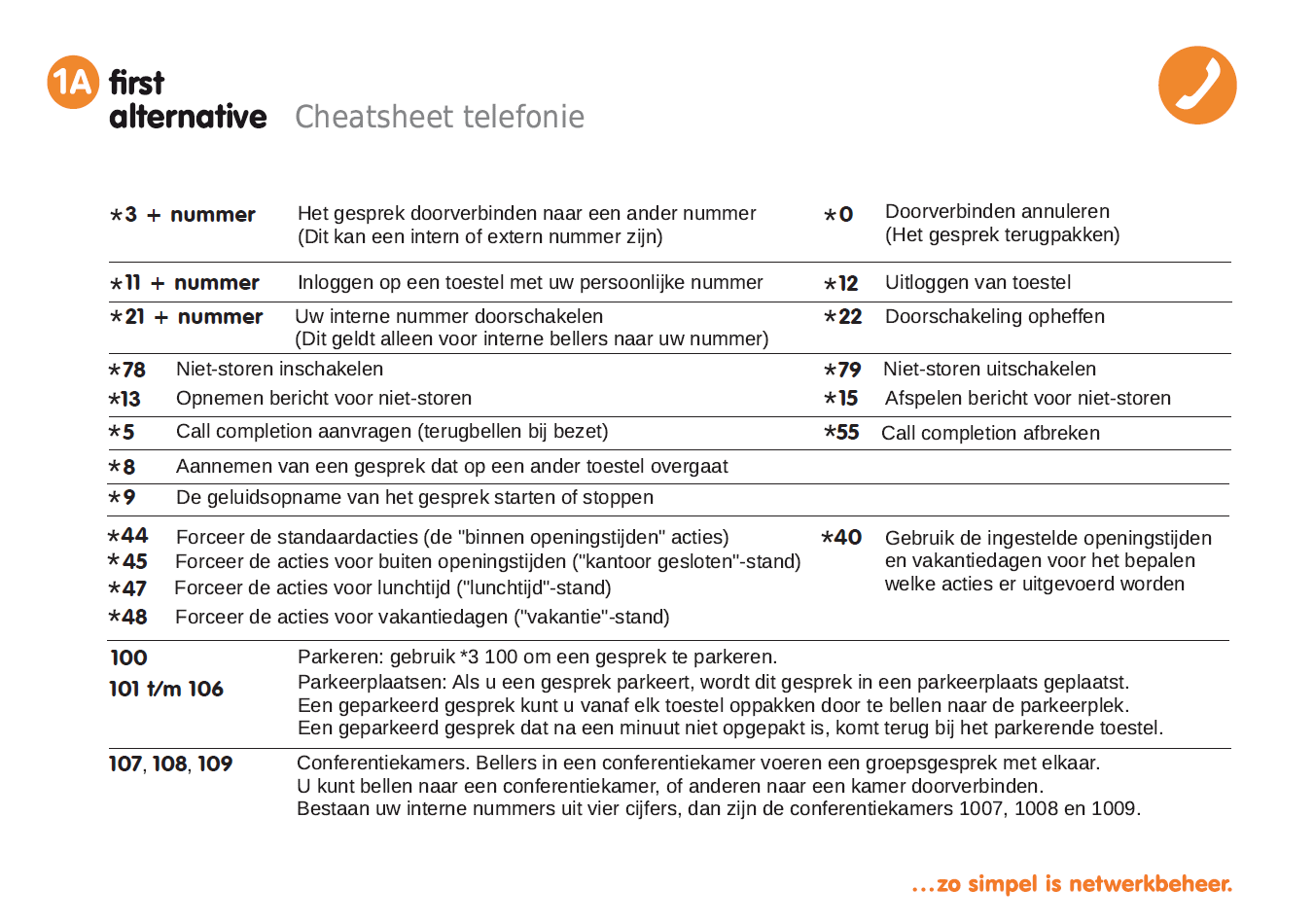VoIP: daily use
This manual is intended for 1A telephony users. This manual explains the most commonly used 1A telephony functions for daily use.
1A-telephony consists of the 1A VoIP module (the telephone exchange) and a number of SIP phones (phones suitable for VoIP). Every user can manage his/her personal settings with the Phonetool.
The general settings for 1A-telephony are controlled by your own 1A administrator (see the manual Telephony for the 1A-manager). You can manage your personal settings yourself through the Phonetool. For an overview of the shortcuts which you can use, see the manual VoIP: summary.
Requirements
To complete this manual, you will need:
- Telephony on your 1A-server. No telephony yet? Please contact your 1A-partner.
- A computer with the Phonetool installed (this is done automatically on Windows computers in the company network)
- A SIP phone connected to the 1A-server
- Your user number for telephony (if unknown, ask your 1A administrator)
Usage
1
Tools:
- General settings for the 1A-telephony will be managed by the people that have access to your organisation's 1A-manager.
- The Phonetool offers the following functions for all users:
- An overview of currect activity in the phone-system.
- A "Call now" function with an addressbook containing shared contacts with phone-numbers.
- An overview of your recent calls (incoming and outgoing).
- Control over several settings for your internal number.
- Codes for functions that you can dial on your phone can be looked up in manual VoIP: in het kort.
- Several applications can be connected to 1A-telephony. For these applications a screen can be opened based on the phone-number of the external caller. These connections are usually set-up for the entire organisation.
2
Using the cheatsheet
- Download the
 Cheatsheet telefonie
Cheatsheet telefonie - Open the Cheatsheet in a PDF program, for example Adobe Acrobat Reader
- The Cheatsheet can also be viewed by clicking on the logo in the Phonetool

3
Calling external numbers
- Numbers that start with a 0 will always be interpreted as external numbers by the telephone exchange. This means that you do not have to enter a special number to get an outside line, but you will have to enter the regional code.The only exception to this rule is 112, which is always the national emergency number.
- Limiting outgoing destinations for a user: 1A-telephony uses calling profiles for each user and each phone. The profiles limit which numbers and distances can be called, this only applies to outgoing calls. When a user tries to make a call that is not within their profile, they will receive a notification and the call will be cancelled. Profiles can be edited by the network administrator in the 1A-manager.
Calls to 112 are always allowed, independent of the user's or telephones profile.
4
Calling internal numbers
- The length of an internal phone number will always be between two and four digits. When a number is dialed that does not start with a 0, this will be interpreted as an internal number by the telephone exchange.The only exception to this rule is 112, which is always the national emergency number.
5
Transferring a call
- A call can be transferred during a call by dialing the code *3 (asterisk–3). After that you can dial an internal or external number you would like to transfer the call to.
It is possible to transfer a call to an internal number that has been forwarded. The call that you are trying to transfer will also be forwarded. - You can perform an attended or an unattended transfer.
- Attended transfer: You wait until the call is answered and talk to your colleague before handover, the call will only be forwarded once you put down the receiver.
- Unattended transfer: As soon as the call you are trying to forward is ringing, you can put down the receiver.
- Cancelling an attended transfer can be done by dialing *0 (asterisk–0), the call will be returned to you.
Transferring a call: *3 + nummer
Cancelling the transfer: *0
6
Receiving calls
- You can be called on both your internal phone number and your personal number (when you are logged into a telephone handset). When an external call arrives, the telephone exchange will check the internal numbers and logged-on numbers and call the number to which to call applies. For each line your 1A administrator can define a primary and secondary group in the 1A-manager.
7
Log in and log out
- In the 1A telephone exchange both users and handsets can be defined and will both receive their own profile.
- A phone is always reachable on it's internal number, if correctly connected and not in DND mode.
- A telephony user can only be reached when (s)he is logged into a phone.
- When you have logged in on a phone, you can be reached on two numbers: your user number and the phone's number. You can log in on any phone, but you can only be reached on the phone on which you logged on last. This way your user number follows you to the phone you are currently at, and no phone will ring when you are not logged in.
- You can log in on a phone by using the code *11 (asterisk–11) followed by your user number (which can be found in the 1A-phonetool). If you were still logged in on another phone, you will be logged off on that handset. You can log out by dialing the code *12 (asterisk–12).
Logging in: *11 + user number
Logging out: *12
8
Special functions: internal - Do not disturb (DND)
- If you set your internal number to do-not-disturb, your phone will not ring anymore, not even for external calls.
- You can activate this status by dialing *78 and deactivating by dialing *79. When you log off from the handset or switch to another one, this option is deactivated as well.
- Internal callers will hear your notification message. A personal message for do-not-disturb can be recorded and listened to via the Personal tab in the Phonetool, or by dialing *13.
Personalize 'Do not disturb' message: *13
Activate 'Do not disturb': *78
Deactivate 'Do not disturb': *79
9
Special functions: internal - Forwarding your number
- Your internal number can be forwarded by dialing code *21 (asterisk–21) and then entering the number to which the line should be forwarded. With this option only internal callers will be forwarded. The forwarding can be made to an internal or external number. These settings are also available on the Personal tab in the Phonetool.
Forwarding calls: *21
10
Special functions: internal - Call Completion
- If you dial an internal number, but the other person is occupied, dial *5 before hanging up to request Call Completion. Hang up, and you will be automatically called back as soon as the other person becomes available. When you answer, the telephone system will establish a call to the other person. To cancel a previously requested call completion, call *55.
Request Call Completion: *5 (during a call)
Cancel Call Completion: *55
11
Special functions: internal - Switch system to office open/closed mode
- Usually the phone system automatically switches between modes as configured through the 1A-manager.
- Sometimes it can be convenient to manually switch the phone system to "office open", "office closed", "lunchtime" or "holiday" mode. For instance if your office closes early, or when lunchtime is not at set times.
- Call *44 to put the phone system in "office open" mode, the phone system will now forcibly use the "standard actions", settings for "lunchtime", "outside office hours" and "holidaymode" will be ignored.
- Call *45 to put the phone system in "office closed" mode, the phone system will now execute the actions which have been specified for outside office hours.
- Call *47 to put the phone system in “lunchtime” mode, the phone system will now use the actions which have been set for lunchtime.
- Call *48 to put the phone system in “holiday” mode, the phone system will now use the actions set for holidaymode.
- Call *40 to undo earlier forced settings, the phone system will go back to using the configured office hours.
- Summarized:
Use the system settings for office hours: *40
Always use the default actions: *44
Always use the actions for outside office hours: *45
Always use the actions for lunchtime: *47
Always use the actions for holidaymode: *48
12
Special functions: voicemail messages
- Listening from an e-mail: Voicemail messages are always sent by e-mail to the e-mail address that you have entered via the 1A-manager in the settings of the outside line. In this email, the voicemail message is added as an audio file so that you can play it on almost all devices.
- Listening from an internal phone: If an internal number is assigned to the external line in the external line settings, you can also listen to voicemail messages from an internal telephone. From an internal device, call * 77XXX, where XXX is the internal number of the external line. To access the voicemail a pin has to be entered, this pin can be found in the 1A-mananger at the settings of the outside line.
13
Special functions: Company specific messages
- Company specific messages can be recorded through the Phonetool tab Global.
This option uses your internal phone, you will be guided by a menu in Dutch. - The recorded messages can then be selected for the available actions in the Phonetool and the 1A-manager.
Steps
1
Settings: external callers - actions for incoming calls
- For every Incoming Line you can decide how incoming calls will be handled. Several different actions can be performed in succession.
- Standard available actions: IVR-menu, Ring a group of phones, Call-queue with music on hold, Voicemail, Transfer to an external number
- You can modify these settings through the 1A-manager. If you want assistance or have questions, please let us know.
2
Settings: external callers - different actions on different moments
- For every Incoming Line there are five availability-modes, for each availabitity-mode different actions can be configured.
- Standard available availability-modes: Daymode, Nightmode, Lunchmode, During Holidays (self-defined), Forced-action
- You can modify these settings through the 1A-manager. If you want assistance or have questions, please let us know.
3
Settings: Busy Lamps on a phone
- Support for Busy Lamp Fields (BLF) is available for several functions.
- For example: Phones, Conferencerooms, Parked calls, Ringing calls on your Incoming Lines, Forced daymode and Forced nightmode
- Busy Lamp Fields can be configured on phones that support this function.
